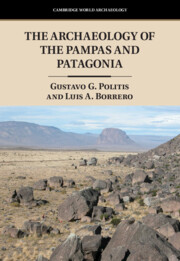Book contents
- The Archaeology of the Pampas and Patagonia
- Cambridge World Archaeology
- The Archaeology of the Pampas and Patagonia
- Copyright page
- Dedication
- Contents
- Acknowledgments
- Chapter 1 Introduction
- Chapter 2 Historical Background
- Chapter 3 Resources: Prey, Plants, and Stones
- Chapter 4 The Early Peopling: The Late Pleistocene to Early Holocene
- Chapter 5 The Middle Holocene (~ 8200–4200 cal BP; ~ 7500–3800 BP)
- Chapter 6 The Late Holocene Diversification (~ 4200 cal BP to ~ 400 cal BP; ~ 3800 BP to ~ 400 BP)
- Chapter 7 Final Remarks
- Select Bibliography
- Index
Chapter 7 - Final Remarks
Published online by Cambridge University Press: 14 February 2024
- The Archaeology of the Pampas and Patagonia
- Cambridge World Archaeology
- The Archaeology of the Pampas and Patagonia
- Copyright page
- Dedication
- Contents
- Acknowledgments
- Chapter 1 Introduction
- Chapter 2 Historical Background
- Chapter 3 Resources: Prey, Plants, and Stones
- Chapter 4 The Early Peopling: The Late Pleistocene to Early Holocene
- Chapter 5 The Middle Holocene (~ 8200–4200 cal BP; ~ 7500–3800 BP)
- Chapter 6 The Late Holocene Diversification (~ 4200 cal BP to ~ 400 cal BP; ~ 3800 BP to ~ 400 BP)
- Chapter 7 Final Remarks
- Select Bibliography
- Index
Summary
The chapters presented before showed diverse historical trajectories, different adaptive patterns, and continuous human occupation of the Pampas and Patagonia since the end of the Pleistocene. Both regions were probably among the last continental lands, except Antarctica, colonized by Homo sapiens after their dispersal from Africa. The first outcome of this review of the archaeology of the Pampas and Patagonia is that it does not support a pre-15,000 cal BP human occupation of the Southern Cone. Putting this in the global discussion means that the Pampas-Patagonia peopling holds up a pre-13,000 cal BP (the so-called pre-Clovis Model) but post–Late Glacial Maximum human arrival at the continent, which is in agreement with current archaeological, ancient DNA, and paleoclimatic models (Llamas et al. 2016; Pitblado 2011; Posth et al. 2018; Prates et al. 2020; Sutter 2021; Waters and Stafford 2013). Moreover, most of the paleoclimatic evidence supports the hypothesis that the earliest human arrivals at the Pampas and Patagonia took place under cold climatic conditions in semiarid to arid environments (Borrero and Martin 2018; Prado et al. 2021) during the cooling period known as the Antarctic Cold Reversal (14,700–13,000 cal BP).
- Type
- Chapter
- Information
- The Archaeology of the Pampas and Patagonia , pp. 245 - 284Publisher: Cambridge University PressPrint publication year: 2024

